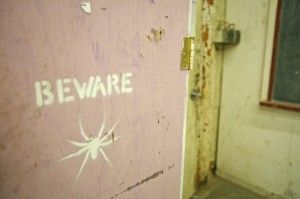Art and design Foundry shows its cracks

September 26, 2012
Several campus personnel familiar with the Foundry, a two-building SIUC art and design complex, say the building is due for some renovations.
Although some safety concerns have been addressed within the building, issues remain, including holes in a wall, a brown recluse spider problem, leaking faucets and crumbling insolation, said Jerry Monteith, head of Graduate Studies for Art and Design.
After the St. Louis Pulitzer Building’s construction in 2001, the university was offered an auxiliary structure used during construction as a potential replacement for the Foundry, Monteith said. However, the university declined because of the extensive process it would require to move the structure to Carbondale, he said.
Advertisement
Monteith said prospective students are sometimes turned off by the Foundry’s condition.
Because of the building’s close proximity to Thompson Woods, the structure has a history of animal infestations, Monteith said.
A groundhog once burrowed its way underneath the Foundry, he said, and it created a hole in one of the work areas.
“I stepped over on the ground around the hole, and my foot went down (into the hole) to above my ankle,” Monteith said.
Signs around the building warn students to be cautious of brown recluse spiders, which Monteith said have been spotted within the foundry on a regular basis.
During the 2001 construction of the Dorothy Morris statue, located in the Dorothy Morris Gardens behind Faner Hall, the university used some of the statue’s grant funding to install air conditioning in one area of the Foundry. However, the rest of the building remains without a cooling system. Monteith said because of perforations in the one air-conditioned room, students often cannot cool off unless they stand directly underneath the system.
The summer can be an especially hard time in the Foundry, Moneith said. While working there this summer, he said he had to change clothes every hour from excessive sweat. He said working outside could be a solution.
Advertisement*
“If the university were able to do a minimal thing for us, it would probably be the construction of some sort of place outside that is covered,” he said.
One of the complex’s buildings has a bathroom without a sink. The sink students use to wash their hands has a leak, which is a problem Monteith said has existed for as long as he can remember. He said the enamel has completely worn off the sink.
Along with the bathroom’s ware, insulation has worn down and is beginning to crack in several rooms.
Mira Rychner, a studio technician at the Foundry, said Plant and Service Operations is usually good about fixing Foundry problems. Recently, the university filled a badger hole located within one of the buildings, she said.
Rychner said students and technicians in the building also perform some of their own upkeep such as maintaining the building’s tools.
“We’re doing our best to turn it around and make it something students can feel comfortable in,” she said.
Phil Gatton, director of Plant and Service Operations, said the last project the school worked on at the Foundry concerned a dust collection system several years ago.
“We had some environmental concerns, and I think the Center for Environmental Health and Safety was out,” he said. “They made some recommendations, and we came in and cleaned up some of those (and) put in some new equipment.”
Although nothing is on the Plant and Service Operations’ priority list concerning the building, Gatton said any life or health issues that may come up take precedence.
Adam Mulder, a graduate student in art and design from Stillwater, Okla., said the building has both positives and negatives.
Mulder mentioned that the building’s location near Evergreen Terrace is nice.
“I like that it’s secluded,” he said. “You can work without being bothered too much.”
However, he said the building could use extensive reworking.
“I think they are almost to the point where they should just redo it,” he said.
Mulder said more space for projects such as woodworking would also be a plus.
“I just worry about safety issues because of how dilapidated parts of the building are,” he said.
Advertisement








